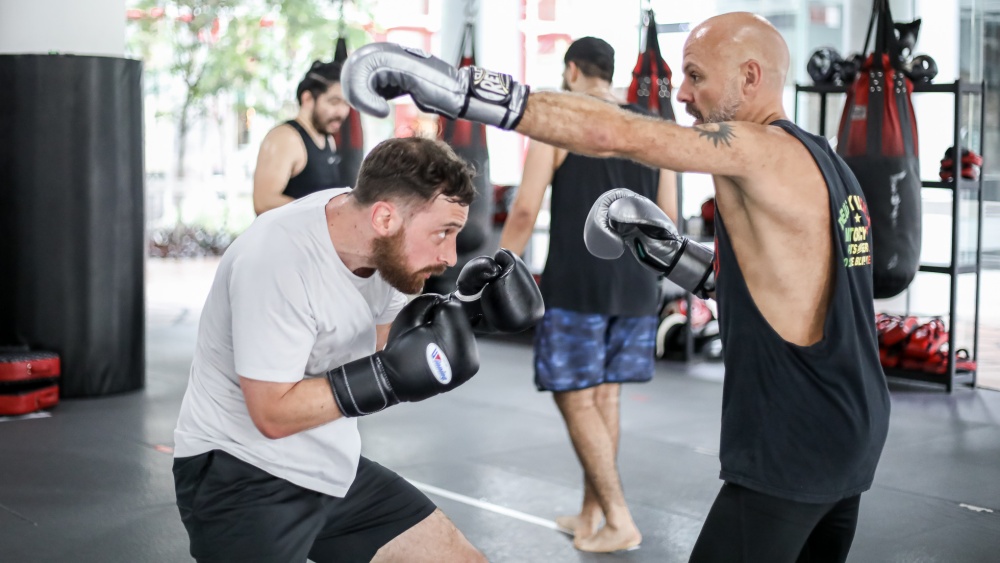At the highest levels of boxing, good head movement is a prerequisite to good defense, and a very important ingredient to success. When the going gets rough, and your opponent is firing from all angles, head movement can get you out of trouble, and keep you out of harm’s way.
Good head movement technique can also seep into your offense, as it sets up counter opportunities that allow you to catch elusive opponents. Being able to slip punches, duck under, and then deliver your counters will set you apart from the competition.
The greatest boxers in history have employed exceptional head movement — Pernell Whitaker, Roy Jones Jr., Muhammad Ali, Mike Tyson, Floyd Mayweather. The list goes on and on.
The goal of having good head movement is to offer your opponents a moving target, rather than a stationary one that is easy to hit. The better your head movement, the harder it will be for your opponents to land clean.
Rather than traditionally trying to block and parry with your hands, you can move your head from side to side, forward and backward, and in various compound motions. The goal is to also adapt to your opponent’s offense, and react based on the combinations he throws.
It’s no doubt one of the most important aspects of boxing. Having good head movement will improve your quality as a boxer. Let’s take a look at a few head movement drills you can perform to help you get better in this area of your game.
Today, Evolve Daily shares various head movement techniques for boxing and how to train them.
1) Duck And Pivot
https://www.youtube.com/watch?v=QbYIX86ESN8
By simply changing your levels, you can duck underneath an opponent’s punch to get out of the way. This works best against straight punches.
Most of the time, your opponent will try to hit you with a jab or a straight. These two are the most common punches in boxing, and ones that you will most often run into. By ducking, you not only evade these punches correctly, but you’ll also have a window to pivot and counter.
Duck underneath an opponent’s punch, then plant your lead foot and pivot away with your rear foot to move off the centerline. You’ll wind up off-angle to the side of your opponent, and from there, you can hit him with a counter.
2) Bob And Weave
Bobbing and weaving is similar to the duck and pivot, but adds an element of movement on the Z-axis. So you’re not just ducking underneath a punch by elevating your head up and down, but you’re also combining this movement with a side-to-side sway.
The bob and weave is commonly followed by a counter left or right hook, depending on which side you wind up on. It’s also much quicker than the duck and pivot, and much more fluid.
3) Slip And Counter
Next up is the slip and counter, which is a reactionary defensive tactic that allows you to move your head ever so slightly to the left or right of a punch, and then deliver a sharp counter usually in the form of a hook or a straight. Unlike the duck and pivot, or bob and weave, you simply slide your head to the side.
The slip and counter is unique because the slight and swift movement of the head is unexpected and very hard to read. You basically time your opponent’s punch, and then just before impact, move your head off the centerline. Simultaneously, you can throw a quick and powerful counter that your opponent will not expect.
4) Pull And Counter
Last but not least, the pull and counter requires you to move your head backward and out of range before delivering a straight punch to counter.
When your opponent throws a jab or a straight, they commit to the punch by moving forward. This is to draw power into their punch. If you can evade this by moving not just your head, but also your torso backward, you’ll make your opponent miss, and you can tag him with a powerful counter.
Pulling your head back, however, is an art form. It takes lots of practice to get the timing and spacing down correctly. If your opponent also has a long reach, pulling might be very difficult, so proceed with caution.
How To Work On These Techniques
There are many different ways you can train head movement. Each training methodology offers various benefits. Make sure to try them all, and you’ll have pro-level head movement in no time.
1) Shadowboxing

Shadowboxing is one of the most effective boxing workouts that will help you improve all areas of skill.
Stand in front of a mirror to see yourself and observe how you move your head. Try all the different sorts of head movement techniques and attempt to make the movements quick, fluid, deliberate, and precise.
While shadow boxing, you also need to frame your mind as if you were in an actual fight or competition. Imagine your opponent standing in front of you, attacking you, while you use your head movement to defend yourself.
Shadowboxing may be a solitary exercise, but it’s greatly effective.
2) Mitt Work

With your trainer or partner, work on your head movement by evading the punch mitts.
A good punch mitt session doesn’t just involve a boxer hitting the pads, but also the trainer trying to simulate the offense of an opponent. Mitt work will also allow you to practice the most commonly used evade and counter techniques.
Work constantly with the mitts and you’ll accustom your body to the natural ebb and flow of a fight. There’s a certain pace that comes with fighting, and you’ll only be able to familiarize yourself with it by practicing.
3) Double End Bag

The double end bag is a great tool for practicing head movement. In particular, this simulates an opponent coming back with a counter after you’ve delivered your combination. We mustn’t forget that our opponents can counter too, and that we’ll be faced with this situation often in a real fight.
Hit the double end bag hard as it bounces back and forth erratically. Move your head in reaction to the bag’s motion and try not to get hit. This is also a great way to practice the pull and counter.
4) Sparring

Finally, you’ll improve head movement best by sparring with your gym mates. Whether it’s light or hard sparring, practice your head movement in the heat of battle. There’s no better way to get used to evading punches than in actual combat.
Like every technique in martial arts, the more experience you have in dealing with this in practice, the better you’ll be able to execute in competition. So spar well and spar often.
It’s one thing to know how to perform your techniques by the book, but when you climb in the ring and are faced with situations where you have to combine both offense and defense, things change. Real-world combat is not something we are prepared for from the get-go. But with the help of sparring, we can accustom ourselves to the high-intensity environment of a fight.
You may also like:

















